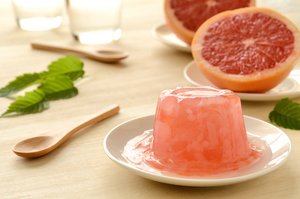Free from gelatine
Symptoms of gelatine intolerance
Allergy to gelatine is very rare. Gelatine is a mixture of animal proteins used in foods that dissolve in the mouth. Gelatine is very often found in sweets (jelly babies, pudding, sweets, jelly), but also in aspic, canned ham, low-fat spreads and juices.
An allergy to gelatine manifests itself as reddening of the skin, wheals, feelings of weakness, tightness in the chest and breathing difficulties in asthmatics. An allergy to gelatine is diagnosed with the help of various allergy tests, such as the prick test, scratch test and the radio-allergo-sorbent test (RAST). Those affected should avoid products containing gelatine. The problem is that gelatine counts as food and therefore does not have to be labelled separately as an additive on the packaging. This makes identification and thus shopping more difficult for allergy sufferers.

Gelatine is a mixture of tasteless animal proteins. The main component is denatured or hydrolysed collagen, which is produced from the connective tissue of various animal species, especially pigs and cattle.
Gelatine lacks the essential amino acid tryptophan and is not considered a complete dietary protein. In unpurified form, gelatine is also known as glutin glue.
For extraction, the initially insoluble connective tissue of (mainly) skin and bones of pigs and cattle, but also of poultry and fish, is subjected to a digestion process (hydrolysis) that breaks the peptide bonds so that the collagen thus made water-soluble can be extracted. The digestion can be carried out by boiling (production of a broth in the kitchen) or by treatment with acids and bases and subsequent extraction (industrial production). Gelatine can contain 1-2 % inorganic substances and up to 15 % water.
Pharmaceutical technology
Gelatine is used for the production of hard and soft capsules. The medicinal substance is filled into such gelatine capsules, processed with any necessary excipients. Gelatine can also be used as a thickening agent to increase the viscosity of liquid medicinal preparations. Of the many types of gelatine, practically only gelatine A (obtained by acid digestion) or gelatine B (obtained by alkaline digestion) are used. In medical technology, gelatine is used, among other things, to coat implants such as vascular prostheses.
Further information: Wikipedia "Gelatine"
